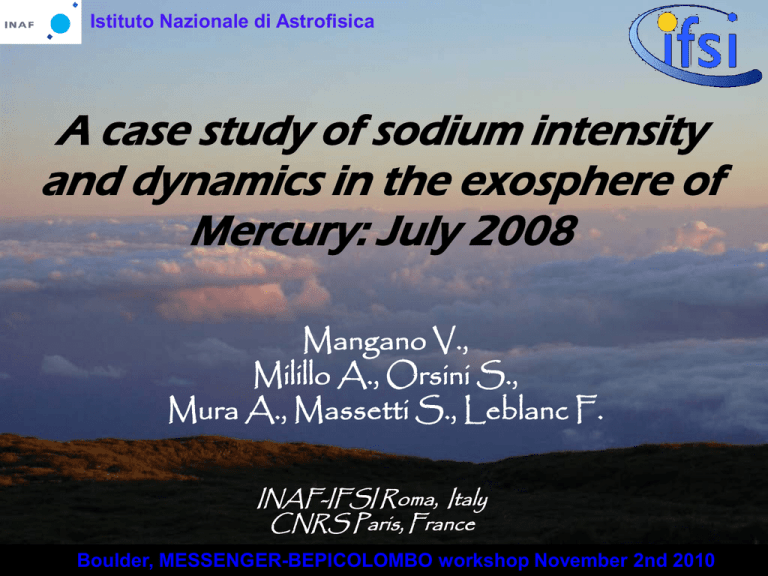A case study of sodium intensity Mercury: July 2008 Mangano V.,
advertisement

Istituto Nazionale di Astrofisica A case study of sodium intensity and dynamics in the exosphere of Mercury: July 2008 Mangano V., Milillo A., Orsini S., Mura A., Massetti S., Leblanc F. INAF-IFSI Roma, Italy CNRS Paris, France Boulder, MESSENGER-BEPICOLOMBO workshop November 2nd 2010 Istituto Nazionale di Astrofisica THEMIS 0.90 m Solar Telescope F/16 Ritchey-Chretien telescope in alt-az mounting Helium filled telescope tube MTR mode for multiline spectropolarimetry Spectral range 400 to 1000 nm at : R ~ 220,000 Slit: 0.5" & 120 " long R ~ 400,000 Slit: 0.25" & 70 " long (low and high resolution) Spectral resolution 0.027 Å to 0.016 Å Spectral dispersion 10.2 to 6 mÅ Two individual cameras: D1 Na at 5896 Å & D2 Na at 5889 Å THEMIS – Observatorio del Teide, Tenerife Lat.: N 28° 18' 12.42" Long.: W 16° 30’ 32.04" Elevation: 2429 m Four years of campaign (2007-2010) : ~ 100 days of observation Boulder, MESSENGER-BEPICOLOMBO workshop, November 2nd 2010 Istituto Nazionale di Astrofisica Boulder, MESSENGER-BEPICOLOMBO workshop, November 2nd 2010 Istituto Nazionale di Astrofisica THEMIS Mercury database 2007: May, 4 days, 14 scans October, 3 days, 18 scans 2008: April, 8 days, 44 scans July, 8 days, 52 scans September, 4 days, 7 scans November, 3 days, 5 scans 2009: April, 8 days, 73 scans June, 7 days, 33 scans July, 1 day, 3 scans August, 6 days, 32 scans October, 9 days, 43 scans 2010: May, 7 days June, 5 days July, 6 days September, 6 days Boulder, MESSENGER-BEPICOLOMBO workshop, November 2nd 2010 Istituto Nazionale di Astrofisica Selected periods orbital conditions 1) July 2008, 12th to 18th TAA 299° ÷ 341° 3) October 2009, 16th to 26th TAA 70° ÷ 112° Phase Angle -73° ÷ -45° Phase Angle -42° ÷ -16° Illum. Disk Illum. Disk 64 ÷ 85% 86 ÷ 97% Dusk terminator Dusk terminator Eclipt. Latitude -3.6° ÷ +1.3° Eclipt. Latitude -5.4° ÷ -1.8° 2) June 2009, 24th to July 1st TAA 280° ÷ 315° 4) April 2009, 17th to 24th TAA 36° ÷ 75° Phase Angle -75° ÷ -51° Phase Angle 69° ÷ 98° Illum. Disk Illum. Disk 62 ÷ 80% 67 ÷ 43% Dusk terminator Dawn terminator Eclipt. Latitude 6.9° ÷ 4.3° Eclipt. Latitude 6.4° ÷ 6.8° Boulder, MESSENGER-BEPICOLOMBO workshop, November 2nd 2010 Istituto Nazionale di Astrofisica Period 1: July 12-18, 2008 Boulder, MESSENGER-BEPICOLOMBO workshop, November 2nd 2010 Istituto Nazionale di Astrofisica Period 2: April 17-24, 2009 Boulder, MESSENGER-BEPICOLOMBO workshop, November 2nd 2010 Istituto Nazionale di Astrofisica Period 3: June 24-July 1, 2009 Boulder, MESSENGER-BEPICOLOMBO workshop, November 2nd 2010 Istituto Nazionale di Astrofisica Period 4: October 16-26, 2009 Boulder, MESSENGER-BEPICOLOMBO workshop, November 2nd 2010 Istituto Nazionale di Astrofisica Boulder, MESSENGER-BEPICOLOMBO workshop, November 2nd 2010 Istituto Nazionale di Astrofisica The IMF geometry on the ecliptic plane is derived by: Me V E Ma CCMC (http://ccmc.gsfc.nasa.gov/models/index.php) Massetti et al., PSS 2007 Mercury is in the blue sector and also the Earth is in the blue sector in accordance with the ACE data at L1. This supports a Bx>0 configuration. Boulder, MESSENGER-BEPICOLOMBO workshop, November 2nd 2010 Istituto Nazionale di Astrofisica + south + equator + north Boulder, MESSENGER-BEPICOLOMBO workshop, November 2nd 2010 Istituto Nazionale di Astrofisica (from Leblanc et al., ICARUS, 2010) Boulder, MESSENGER-BEPICOLOMBO workshop, November 2nd 2010 Istituto Nazionale di Astrofisica ... south ... equator ... north Boulder, MESSENGER-BEPICOLOMBO workshop, November 2nd 2010 Istituto Nazionale di Astrofisica Boulder, MESSENGER-BEPICOLOMBO workshop, November 2nd 2010 Istituto Nazionale di Astrofisica Boulder, MESSENGER-BEPICOLOMBO workshop, November 2nd 2010 Istituto Nazionale di Astrofisica Boulder, MESSENGER-BEPICOLOMBO workshop, November 2nd 2010 Istituto Nazionale di Astrofisica July 13th, 2008 Observations Comparison: vs Simulations Boulder, MESSENGER-BEPICOLOMBO workshop, November 2nd 2010 Istituto Nazionale di Astrofisica Boulder, MESSENGER-BEPICOLOMBO workshop, November 2nd 2010 Istituto Nazionale di Astrofisica Boulder, MESSENGER-BEPICOLOMBO workshop, November 2nd 2010 Istituto Nazionale di Astrofisica Boulder, MESSENGER-BEPICOLOMBO workshop, November 2nd 2010 Istituto Nazionale di Astrofisica Boulder, MESSENGER-BEPICOLOMBO workshop, November 2nd 2010 Istituto Nazionale di Astrofisica Agreement between the observation and simulation performed is promising, reproducing both the decrease rate and the intensity reasonably well, before the second peak occurs. (See A. Mura presentation on Wednesday 3rd,session 4). Boulder, MESSENGER-BEPICOLOMBO workshop, November 2nd 2010 Istituto Nazionale di Astrofisica (preliminary) Conclusions 1) interesting results from THEMIS observations thanks to daily runs of up to 1012 hours. 2) intensity variations on scales of 1 hour and more are clearly visible. 3) the analysis of the period of July 2008 (8 consecutive days) permits the (still partial) analysis of a longer period evolution, in accordance with TAA position, and with the modeled Bx component of the IMF. 4) daily peaks are observed as well, with a persistence of the southern emission, and an 'echo' in the northern emisphere, while the equatorial emission appear to be not directly related to them. 5) our model simulation is in reasonable agreement with the observed evolution on July 13th 2008, suggesting an improved comprehension of the causes of the processes acting on a time-scale of few hours. Boulder, MESSENGER-BEPICOLOMBO workshop, November 2nd 2010